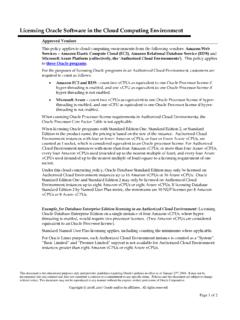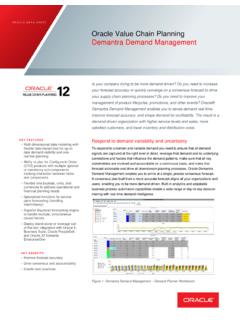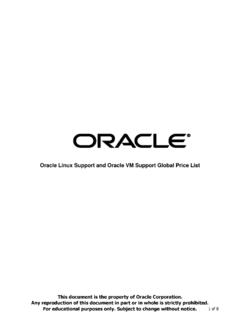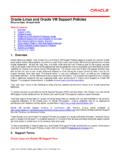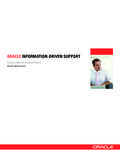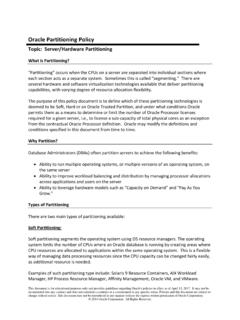Transcription of Oracle Partitioning Policy
1 This document is for educational purposes only and provides guidelines regarding Oracle 's policies in effect as of October 7, 2019. It may not be incorporated into any contract and does not constitute a contract or a commitment to any specific terms. Policies and this document are subject to change without notice. This document may not be reproduced in any manner without the express written permission of Oracle Corporation. 2014 Oracle Corporation. All Rights Reserved. Oracle Partitioning Policy Topic: Server/Hardware Partitioning What is Partitioning ? Partitioning occurs when the CPUs on a server are separated into individual sections where each section acts as a separate system. Sometimes this is called segmenting. There are several hardware and software virtualization technologies available that deliver Partitioning capabilities, with varying degree of resource allocation flexibility.
2 The purpose of this Policy document is to define which of these Partitioning technologies is deemed to be Soft, Hard or an Oracle Trusted Partition, and under what conditions Oracle permits them as a means to determine or limit the number of Oracle Processor licenses required for a given server, , to license a sub-capacity of total physical cores as an exception from the contractual Oracle Processor definition. Oracle may modify the definitions and conditions specified in this document from time to time. Why Partition? Database Administrators (DBAs) often partition servers to achieve the following benefits: Ability to run multiple operating systems, or multiple versions of an operating system, on the same server Ability to improve workload balancing and distribution by managing processor allocations across applications and users on the server Ability to leverage hardware models such as Capacity on Demand and "Pay As You Grow.
3 Types of Partitioning There are two main types of Partitioning available: Soft Partitioning : Soft Partitioning segments the operating system using OS resource managers. The operating system limits the number of CPUs where an Oracle database is running by creating areas where CPU resources are allocated to applications within the same operating system. This is a flexible way of managing data processing resources since the CPU capacity can be changed fairly easily, as additional resource is needed. Examples of such Partitioning type include: Solaris 9 Resource Containers, AIX Workload Manager, HP Process Resource Manager, Affinity Management, Oracle VM, and VMware. This document is for educational purposes only and provides guidelines regarding Oracle 's policies in effect as of October 7, 2019. It may not be incorporated into any contract and does not constitute a contract or a commitment to any specific terms.
4 Policies and this document are subject to change without notice. This document may not be reproduced in any manner without the express written permission of Oracle Corporation. 2014 Oracle Corporation. All Rights Reserved. Unless explicitly stated elsewhere in this document, soft Partitioning (including features/functionality of any technologies listed as examples above) is not permitted as a means to determine or limit the number of software licenses required for any given server or cluster of servers. Hard Partitioning : Hard Partitioning physically segments a server, by taking a single large server and separating it into distinct smaller systems. Each separated system acts as a physically independent, self-contained server, typically with its own CPUs, operating system, separate boot area, memory, input/output subsystem and network resources.
5 Oracle -approved hard Partitioning technologies as listed in this section of the Policy document are permitted as a means to limit the number of software licenses required for any given server or a cluster of servers. Oracle has deemed certain technologies, possibly modified by configuration constraints, as hard Partitioning , and no other technology or configuration qualify. Approved hard Partitioning technologies include: Physical Domains (also known as PDomains, Dynamic Domains, or Dynamic System Domains), Solaris Zones (also known as Solaris Containers, capped Zones/Containers only), IBM s LPAR (adds DLPAR with AIX ), IBM s Micro-Partitions (capped partitions only), vPar (capped partitions only), nPar, Integrity Virtual Machine (capped partitions only), Secure Resource Partitions (capped partitions only), Fujitsu s PPAR. All approved hard Partitioning technologies must have a capped or a maximum number of cores/processors for the given partition.
6 Using IBM processors in TurboCore mode is not permitted as a means to reduce the number of software licenses required; all cores must be licensed. IBM Power VM Live Partition Mobility is not an approved hard Partitioning technology. All cores on both the source and destination servers in an environment using IBM Power VM Live Partition Mobility must be licensed. Oracle Linux KVM or Oracle VM Server may be used as hard Partitioning technology only as described in the following documents: Oracle Linux KVM, only if specific cores are allocated per the following document: Oracle VM Server for x86, only if specific cores are allocated per the following document: Oracle VM Server for SPARC, only if specific cores are allocated per the following document: This document is for educational purposes only and provides guidelines regarding Oracle 's policies in effect as of October 7, 2019.
7 It may not be incorporated into any contract and does not constitute a contract or a commitment to any specific terms. Policies and this document are subject to change without notice. This document may not be reproduced in any manner without the express written permission of Oracle Corporation. 2014 Oracle Corporation. All Rights Reserved. Oracle Solaris Zones may be used as hard Partitioning technology only as described in the following document: Any technology not listed in the Hard Partitioning section of this document is considered soft Partitioning technology. Oracle Trusted Partitions for Oracle Engineered Systems For approved Oracle Engineered Systems, (see table below), Oracle permits the use of Oracle VM Server (OVM) or Oracle Linux KVM as a means to limit the number of Oracle Processor licenses required, , to license a sub-capacity of total physical cores.
8 Oracle s Trusted Partitions Policy also requires use of Oracle Enterprise Manager as described below if both of these conditions are met, the partition is deemed a Trusted Partition. Approved list of Oracle Engineered Systems eligible for Trusted Partitions Oracle Engineered System Version requirement Exalogic Elastic cloud running or higher Exalogic Elastic cloud Software Exalytics In-Memory Machine running Exalytics Base Image for Oracle VM private cloud Appliance running or higher Oracle private cloud Appliance controller software Exadata Database Machine running or higher Exadata Storage Server Software For the purposes of licensing Oracle programs in a Trusted Partition, two (2) virtual CPUs (vCPU) are counted as equivalent to a physical core. Licenses must be procured in increments of 2 physical cores. The customer is required to license the highest number of vCPUs running at any given time (highwater mark), however they are not required to license more than the total number of physical cores in the machine.
9 Hyper-threading must be enabled for processors when using Trusted Partitions. The licensing rules for Trusted Partitions varies across the supported Engineered Systems listed in the table above. For information on Trusted Partitions on Exadata (including minimum cores to be licensed), please see Oracle Exadata Database Machine Licensing Information User's Guide. The minimum for all other engineered systems is two (2) physical cores. This document is for educational purposes only and provides guidelines regarding Oracle 's policies in effect as of October 7, 2019. It may not be incorporated into any contract and does not constitute a contract or a commitment to any specific terms. Policies and this document are subject to change without notice. This document may not be reproduced in any manner without the express written permission of Oracle Corporation.
10 2014 Oracle Corporation. All Rights Reserved. Requirements for Oracle Enterprise Manager For virtual machines to participate under Oracle Trusted Partition based licensing, they need to be monitored by Oracle Enterprise Manager (also known as 12c Release 2) or later. This means that the Enterprise Manager agent should be deployed on the guest operating system running on those VMs. The Enterprise Manager can be configured to run in either connected or disconnected mode. 1) Connected mode: In Connected mode, Enterprise Manager will be connected to My Oracle Support. Enterprise Manager would report on usage locally and also upload to My Oracle Support (requires a current Oracle support contract and valid CSI number). 2) Disconnected mode: In disconnected mode, there is no Internet connectivity. Enterprise Manager would run locally and customers are required to run collections quarterly and maintain a backup of the report.
